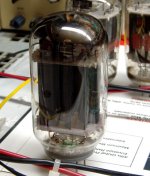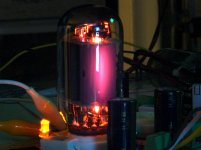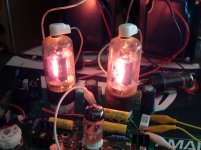I was recently given a nice big box of about 3-400 old used tubes, and despite a dearth of common audio output tubes, there is an abundance (12+) of 6DQ6B's (Octal sweep tubes) that look pretty darn healthy. Also, about 2 dozen 6SN7GTB's (wuhoo!)
So which circuit approach do the 6DQ6B's suggest to you seasoned veterans? I'm not ready to tackle screen drive, I'm still trying to wrap my head around the more pedestrian configurations -- I'm not an EE or pioneer. I realize they use low screen voltages, as most sweep tubes do, but otherwise I'm not sure what special considerations to watch out for. Would these tubes work well as triodes? No UL taps?
Are there any amp designs currently floating around that use similar sweep tubes that I can use as a base, then just adjust the operating parameters to suit? This is just a circuit design learning exercise for me, not a construction project per se.
..Todd
So which circuit approach do the 6DQ6B's suggest to you seasoned veterans? I'm not ready to tackle screen drive, I'm still trying to wrap my head around the more pedestrian configurations -- I'm not an EE or pioneer. I realize they use low screen voltages, as most sweep tubes do, but otherwise I'm not sure what special considerations to watch out for. Would these tubes work well as triodes? No UL taps?
Are there any amp designs currently floating around that use similar sweep tubes that I can use as a base, then just adjust the operating parameters to suit? This is just a circuit design learning exercise for me, not a construction project per se.
..Todd
Last edited:
Incidentally, if anyone needs any one-off tubes of the [mostly] TV pedigree, I probably have what you need. We can trade for something. Just let me know what you're looking for. (I will be keeping/using the standard fare tubes though.) I'm still going through the BIG box and haven't gotten to everything yet.
..Todd
..Todd
build a sodding huge AB1 amp! Start with the datasheet linked from this thread - it gives you the outline for the output end of a 30w to 80w amp - and the drive requirements become reasonably clear based on that.
Miles has built a tame (as in controlled, not lame) and well defined amp based on similar tubes - see the full write-up here.
With the sn7's in the right places and perhaps a bit of sand to assist as required, you could build a killer amp with the 6DQ6-B...
Miles has built a tame (as in controlled, not lame) and well defined amp based on similar tubes - see the full write-up here.
With the sn7's in the right places and perhaps a bit of sand to assist as required, you could build a killer amp with the 6DQ6-B...
Last edited:
build a sodding huge AB1 amp!
Ha ha. Well, I didn't mean I was going to use all of the tubes at once! Just a pair or whatever. Thanks for the info.
Now that I think about it though... nah... well.... nah...
..Todd
Last edited:
there is an abundance (12+) of 6DQ6B's (Octal sweep tubes) that look pretty darn healthy.
I learned how to blow up tubes, and make a few working amplifiers along the way, back in the 1960's. All of my tubes came from the trash dump where the price was right......FREE. I would pull the tubes and transformers out of discarded black and white TV sets. The 6DQ6 and its little brother the 6BQ6 were the most common and the ones that I learned on. I have recently revisited both tube types.
Would these tubes work well as triodes?
It is possible, but they really don't like it. I have stuffed them into a Simple SE and made them work in triode mode, and another Simple SE builder has used them in his amp. The low screen grid voltage rating must be violated to make them work in triode. Every tube acts differently in this regard, so some will work and some will glow.
Are there any amp designs currently floating around that use similar sweep tubes that I can use as a base
I have tried them and at least 20 other sweep tubes in Petes magical red board. The board is designed for 12 pin compactrons but I rigged some octal sockets in mine for testing. You will get about 35 watts with Petes recommended 340 volts of B+ and a 6600 ohm OPT, and over 50 watts with 450 volts.
http://www.diyaudio.com/forums/tubes-valves/151206-posted-new-p-p-power-amp-design.html
Astute tube hackers may realize that the 6DQ6 and the 6BQ6 have the same pinout as the popular 6L6GC except for the plate cap. Connecting a wire from the plate cap to pin 3 makes the SOCKET compatible. This does NOT mean that every 6L6GC based amplifier can use a 6DQ6, but some amps can. The amp must have adjustable bias that goes to -50 volts or so, and you MUST reduce the screen voltage to 150 or so. A big resistor and a 5 watt zener diode works in guitar amps. I have seen an old Bandmaster crank out 70+ watts with a pair of 6DQ6's. Hifi amps might benefit from a better screen supply.
The 6BQ6 will make a Fender Champ SCREAM until the power transformer blows up. I learned this lesson when I was about 12 years old. Thats where it all started. I made several 6BQ6 based "Champs" back then out of old TV parts. I never understood why the little 6BQ6 worked so well in SE amps like the Champ but the 6DQ6 just glowed red and wasn't loud. That was long before I knew about things like impedance, bias, and load lines.
Are there any amp designs currently floating around that use similar sweep tubes that I can use as a base, then just adjust the operating parameters to suit? This is just a circuit design learning exercise for me, not a construction project per se.
Check out W5jag's Simple SE amp on post #107 & 8:
http://www.diyaudio.com/forums/tubelab/125439-another-simple-se-builder-11.html
jeff
My first ham radio transmitter used the 6DQ6 -- keyed the cathode and made TV's go fuzzy all over the neighborhood.
That's probably the result I'll get with an amplifier.
..Todd
I just discovered/realized (discovized?) the 6DQ6B is virtually identical to the 6JN6, besides the obvious form factor mutations, and there are a bunch more designs floating around for the 6JN6 for me to look at.
I prefer the looks of Compactron over Octal, but I guess beggars can't be choosers.
Hi Tubelab, Yeah, Pete's amp is a good reference for me. I think I also have a big pile of those pentodes (6CB6A) he uses for the differential. I'll check when I get home.
It looks like I have plenty of resources to play with.
..Todd
I prefer the looks of Compactron over Octal, but I guess beggars can't be choosers.
I have tried them and at least 20 other sweep tubes in Petes magical red board. The board is designed for 12 pin compactrons but I rigged some octal sockets
Hi Tubelab, Yeah, Pete's amp is a good reference for me. I think I also have a big pile of those pentodes (6CB6A) he uses for the differential. I'll check when I get home.
It looks like I have plenty of resources to play with.
..Todd
I prefer the looks of Compactron over Octal, but I guess beggars can't be choosers.
I think that the 6DQ6 will be more tolerant of abuse despite (or perhaps more fittingly, as a result of) it's ungainly appearance.
So what you're saying is that if a compactron tube can survive a night with George , then the octal version should be pretty much immortal.
UH, why have I melted far more octals than compactrons?
Because they have been around longer and thats all I could get when I REALLY didn't know what I was doing.
I think that some tubes have the same guts in the octal and compactron versions. They are about equal in their meltability.
UH, why have I melted far more octals than compactrons?
Because they have been around longer and thats all I could get when I REALLY didn't know what I was doing.
I think that some tubes have the same guts in the octal and compactron versions. They are about equal in their meltability.
Not 100% sure why jackinnj feels octals are more robust than compactrons, but my guess is because the base is sturdier. And indeed it looks sturdier -- better supported, heavier pins, etc. But I haven't got enough experience to know how they compare in reality. I think Compactrons look nicer though without the octal diaper. It's like a compactron wearing Depends.
It didn't occur to me that he meant structurally robust until after I mentioned your electrical torture. It was just a corny tube torture joke.
Yes, I think the 6DQ6 has the same guts as the 6JN6/6JM6 judging from the datasheet.
..Todd
Last edited:
I've had compactrons where the top just cracked right off!
I have seen only one tube shatter abrubtly during one of my experiments. It was an early Chinese KT88, and it wasn't even glowing. Those tubes remind you that the Chinese invented fireworks. It fried some amp parts when it blew too.
In one of my spud amp experiments I found a 21LR8 that had a crack in the glass running down one side. I cranked that tube till it lit up the workbench expecting it to blow up, but it wouldn't die.
The first picture shows the cracked 21LR8, the second picture shows the tube running at 500 volts plate and screen. The third picture shows that you can get over 20 watts out of a 6BQ6 in a Simple SE, for a minute or two. Makes a good reading light too.
I wouldn't use any of these tubes in an amp, so I "tested" them. The cracked tube can not be trusted and amp damage is a real possibility when a tube breaks. The 6BQ6's were from a box of used and abused TV tubes. At the time new ones were available for 60 to 98 CENTS EACH, so I bought over 100. Used ones were expendable.
Attachments
I was recently given a nice big box of about 3-400 old used tubes
Lucky you!
So which circuit approach do the 6DQ6B's suggest to you seasoned veterans? I'm not ready to tackle screen drive, I'm still trying to wrap my head around the more pedestrian configurations -- I'm not an EE or pioneer. I realize they use low screen voltages, as most sweep tubes do, but otherwise I'm not sure what special considerations to watch out for. Would these tubes work well as triodes? No UL taps?
I wouldn't advise pseudotriode use here. The screen grid voltage limitation makes this not very useful. Also, UL operation might possibly not be necessary. These TV HD types seem to sound pretty good without it. Of course, you're gonna need a hefty power xfmr since these pull some big currents. That does, however, make for easier to design OPTs, since the load impedance doesn't need to be so high.
Since you have so many, and these have the current capability, if you're into something more adventurous, you could make a Circlotron OTL from them.
Yup. Same box of tubes I used to play with 40-some years ago. My dad (pushing 90 now) says "Hey I still have a box of tubes. You want them?"Lucky you!
Gee, let me think about that for few nano-seconds... I thought he was talking about a smallish box until he showed me this 21" colour TV box from the 70's, full of tubes, sorted into boxes of various sizes.
Since you have so many, and these have the current capability, if you're into something more adventurous, you could make a Circlotron OTL from them.
Thanks for chippin in with advice, Miles.
OTL is over my head for the time being. I think I'm going to build a bog-standard push-pull non-UL output section, so I can get a grip on those circuit calculations. Then move backwards towards the input. That's the primary plan for short term, asking plenty of dumb questions along the way.
..Todd
- Status
- This old topic is closed. If you want to reopen this topic, contact a moderator using the "Report Post" button.
- Home
- Amplifiers
- Tubes / Valves
- What to do with 6DQ6B's?


